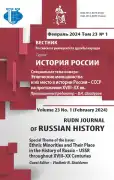Касимовские татары в годы культурной революции в СССР: по материалам региональной печати 1920-1930-х гг.
- Авторы: Галлямова А.Г.1, Ханипова И.И.1
-
Учреждения:
- Институт истории имени Ш. Марджани Академии наук Республики Татарстан
- Выпуск: Том 23, № 1 (2024): ЭТНИЧЕСКИЕ МЕНЬШИНСТВА И ИХ МЕСТО В ИСТОРИИ РОССИИ – СССР НА ПРОТЯЖЕНИИ XVIII–XX ВВ.
- Страницы: 62-73
- Раздел: ЭТНИЧЕСКИЕ МЕНЬШИНСТВА И ИХ МЕСТО В ИСТОРИИ РОССИИ – СССР НА ПРОТЯЖЕНИИ XVIII–XX ВВ.
- URL: https://journal-vniispk.ru/2312-8674/article/view/322074
- DOI: https://doi.org/10.22363/2312-8674-2024-23-1-62-73
- EDN: https://elibrary.ru/MEHTDK
- ID: 322074
Цитировать
Аннотация
Анализируется культурная составляющая социальной жизни касимовских татар в межвоенный период, суть которой сводилась к реализации культурной революции, которая наряду с индустриализацией страны и коллективизацией сельского хозяйства в середине 1920-х гг. была объявлена важной частью трехзвенной программы социалистического строительства. Цель заключается в установлении особенности поведенческого паттерна касимовских татар указанного периода. Источниковая база основана на материалах периодической печати и эго-документах. Показаны условия и реалии «перековки сознания», борьба с пережитками прошлого, сводившаяся к попыткам искоренения религиозных культов и обычаев у касимовских татар. Раскрыт уровень развития, преемственность, специфика локальной трансформации в важнейшем сегменте культурной сферы - образовании и просвещении. Авторы пришли к выводу, что касимовские татары на крутом повороте истории в 1920-е гг. проявили энергию и волю, чтобы стать «равными среди равных» народов, как это декларировалось на официальном уровне. Пытаясь сохранить собственную идентичность, они проявили и свойственный им этатизм, приняв и активно участвуя в преобразованиях в рамках реализации задач культурной революции.
Об авторах
Альфия Габдульнуровна Галлямова
Институт истории имени Ш. Марджани Академии наук Республики Татарстан
Email: alfiya1955@gmail.com
ORCID iD: 0000-0003-4344-902X
SPIN-код: 8335-8920
доктор исторических наук, ведущий научный сотрудник
420111, Россия, Казань, ул. Батурина, 7АИльнара Ильдаровна Ханипова
Институт истории имени Ш. Марджани Академии наук Республики Татарстан
Автор, ответственный за переписку.
Email: ihanipova@mail.ru
ORCID iD: 0000-0001-7585-8069
SPIN-код: 2258-5491
кандидат исторических наук, старший научный сотрудник, заведующий отделом новейшей истории
420111, Россия, Казань, ул. Батурина, 7АСписок литературы
- Abyanov, R.V., and Safarov, M.A. Teni Kasimovskogo khanstva [Shadows of Qasim Khanate]. Moscow: Chitai Publ., 2021 (in Russian).
- Abyanov, R.V., Safarov, M.A. “ ‘Tatar faith.’ The image of Islam among the Russian population of the Ryazan region.” Minbar. Islamic Studies, no. 14 (2021): 310-334 (in Russian). https://doi.org/10.31162/2618-9569-2021-14-2-310-334
- Akimov, V.V. Kasimovskie tatary: mezhdu proshlym i budushchim [Kasimov Tatars: between past and future]. Moscow: Veche Publ., 2004 (in Russian).
- Aksanov, A.V. “Kazanskoe i Kasimovskoe khanstvo [Kazan and Qasim Khanates].” In Tatary, 147-161. Moscow: Nauka Publ., 2017 (in Russian).
- Gordlevskii, V.A. “Elementy kul'tury u kasimovskikh tatar (iz poezdki v Kasimovskii uezd) [Elements of culture of Kasimov Tatars: (from a trip to Kasimov region].” In vol. 10 of Trudy Obshchestva issledovatelei Riazanskogo kraia. Ryazan': Gostipolitografiia Publ., 1927 (in Russian).
- Iskhakov, D.M. “Kasimovskie tatary [Kasimov Tatars].” Tatarstan, no. 1-2 (1994): 78-80 (in Russian).
- Iskhakov, D.M. “Tatary kasimovskie [Kasimov Tatars].” In Narody Rossii. Entsiklopediia, 326-327. Moscow: BRE Publ., 1994 (in Russian).
- Kuftin, B.A. Tatary kasimovskie i tatary-mishari Tsentral'no-Promyshlennoi oblasti. K voprosu vydeleniia oblastnykh tipov i sostavnykh elementov Volgo-Okskoi etnicheskoi kul'tury (Etnicheskoe naimenovanie i elementy zhilishcha) [Kasimov Tatars and Mishar Tatars of the Central Industrial Region. On the issue of elucidating the regional types and constituent elements of the Volga-Oka ethnic culture (Ethnic name and elements of the inhabitation)]. Kul'tura i byt naseleniia Tsentral'no-Promyshlennoi oblasti. Etnologicheskie issledovaniia i materialy, 135-148. Moscow: [N.s.], 1929 (in Russian).
- Makhmutova, L.T. “Starinnaia obriadovaia pesnia u kasimovskikh tatar [An old ritual song among the Kasimov Tatars].” In vol. 2 of Izvestiia Kazanskogo filiala AN SSSR, 217-221. Kazan: Izd-vo Kazanskogo filiala AN SSSR Publ., 1957 (in Russian).
- Makhmutova, L.T. Nekotorye nabliudeniia nad leksikoi kasimovskogo govora tatarskogo iazyka [Some observations on the vocabulary of the Kasimov dialect of the Tatar language].” In vol. 2 of Materialy po tatarskoi dialektologii, 223-235 Kazan': Izd-vo Kazanskogo filiala AN SSSR Publ., 1962 (in Russian)
- Rakhimzyanov, B.R. Kasimovskoe khanstvo (1445-1552 gg.). Ocherki istorii [Kasimov Khanate (1445-1552). History essaus]. Kazan': Tatarskoe knizhnoe izd-vo Publ., 2009 (in Russian).
- Safarov, M.A., and Seitov, E.M. “ ‘If the mosques open, who will visit them?’: Kasimov Tatars religious life in the 1943 on the basis of the data by G.P. Snesarev.” Minbar. Islamic Studies, no. 13 (2020): 330-348 (in Russian). https://doi.org/10.31162/2618-9569-2020-13-2-330-348
- Savin, S.O. “Stolitsa kak tsentr gosudarstvennogo stroitel'stva - istoricheskaia pamiat' o stolichnosti Kasimova [The capital as a center of state building - historical memory of the capital Kasimov].” Sravnitel'naya politika 6. no. 4 (2015): 107-109 (in Russian).
- Sharifullina, F.L. Kasimovskie tatary [Kasimov Tatars]. Kazan: Tatarskoe knizhnoe izd-vo Publ., 1991 (in Russian).
- Simakov, K.M. Ot bylogo do neskonchaemogo nastoiashchego [From the past to the endless present]. St. Petersburg: [N.s.], 2017 (in Russian).
Дополнительные файлы









